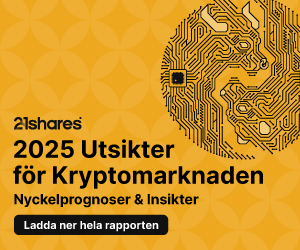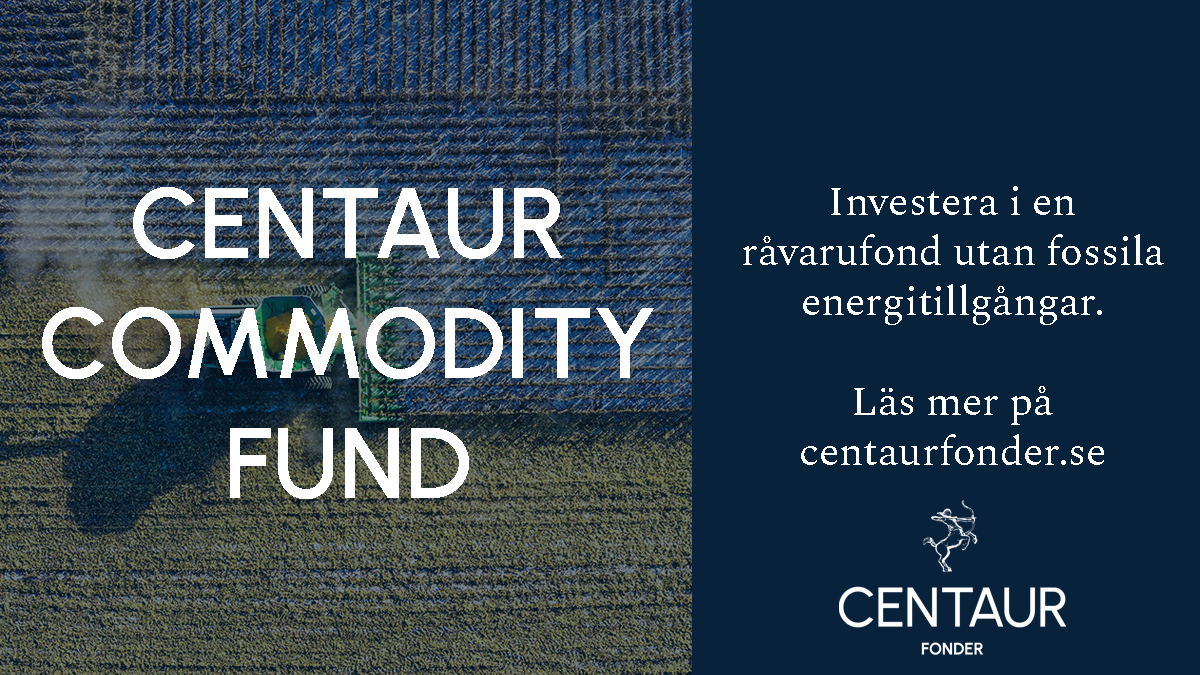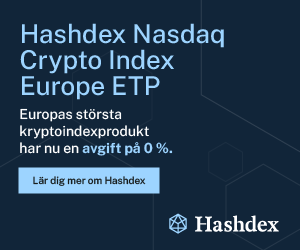Nyheter
Avalanche (AVAX) Research Primer
Publicerad
1 år sedanden
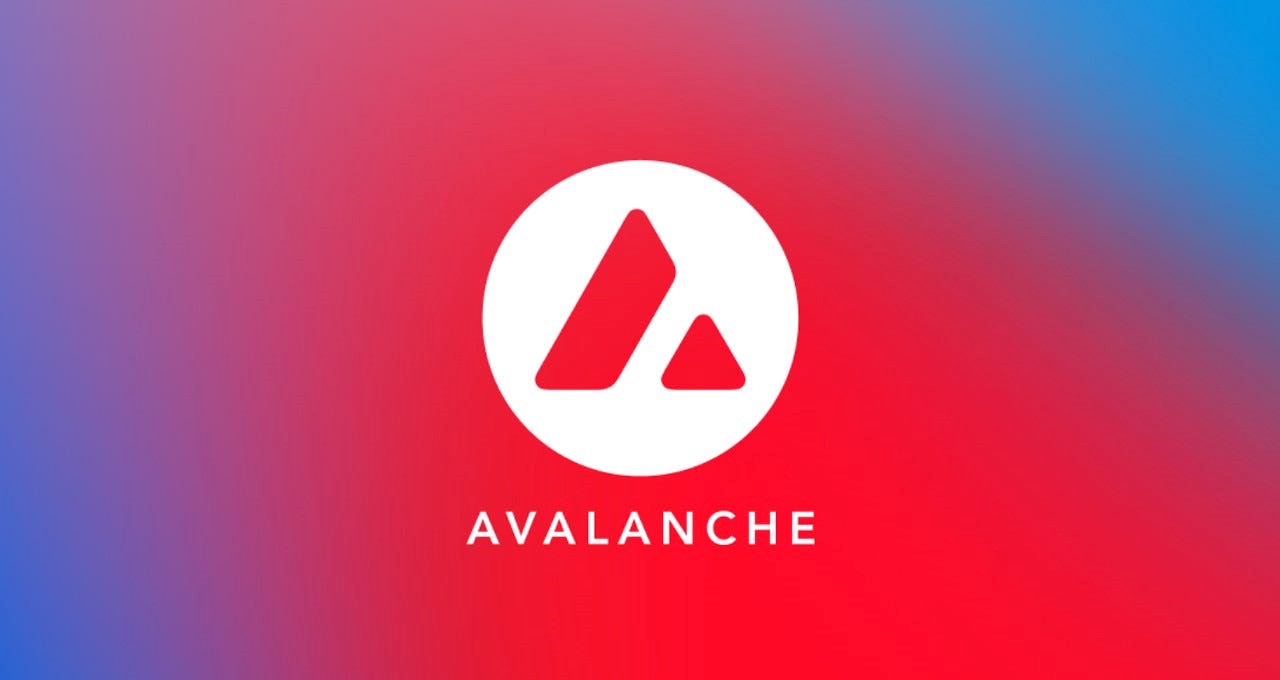
Avalanche (AVAX) is a Proof-of-Stake blockchain using the “Avalanche consensus mechanism”. It is a blockchain network that promises high transaction throughput of 4,500 transactions per second (TPS) and the first smart contract platform that can confirm transactions in under one second. In contrast, Ethereum processes 15 to 30 transactions per second with over 1 minute finality. Avalanche is a high-performance, scalable, customizable and secure blockchain platform targeting building application- specific blockchains, scalable decentralized applications and complex digital smart assets.
Avalanche was launched by Ava Labs in 2020. Emim Gun Sirer, a Turkish- American computer scientist and associate professor at Cornell started Ava Labs in 2018. The company currently has offices in New York City and Miami and was initially funded by Andreessen Horowitz, Polychain Capital, Initialized Capital and angel investors such as Balaji Srinvasan and Naval Ravikant of AngelList.
In this report, 21Shares will offer an exhaustive overview of the Avalanche network, AVAX as a cryptoasset, and discuss the various investment risks associated with AVAX — in addition to how an investor can think about the future value of its underlying cryptoasset. This report offers an exhaustive coverage of Avalanche and AVAX available on the market.
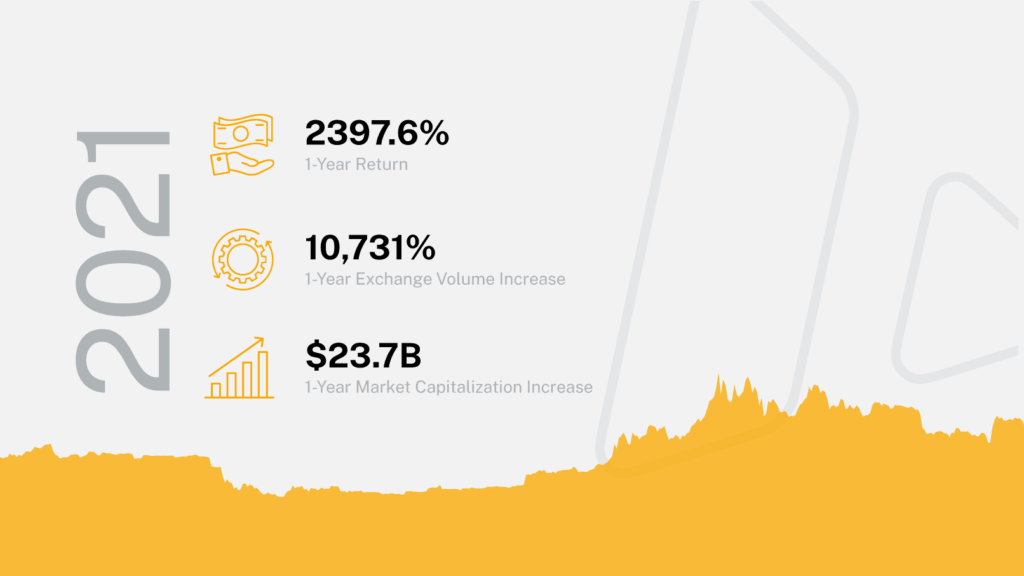
How Avalanche Works
The Avalanche network comprises multiple blockchains and employs a proof of stake consensus mechanism to achieve high throughput of over 4,500 transactions per second. Each chain in the Avalanche architecture represents its own virtual machine, with support for numerous custom virtual machines like EVM and WASM. This allows chains to include case-specific functionality. Each of these virtual machines is connected to a subnet with its own set of incentives to keep validators honest, it is a custom blockchain network made up of ”a dynamic set of validators working together to establish consensus.” As a result, Avalanche might be regarded as a ”platform of platforms,” made up of thousands of subnets that work together to build a single interoperable network.
The Avalanche Consensus Protocol is a family of four mechanisms — Slush, Snowflake, Snowball, and Avalanche, these build upon each other and become more secure in the process. In short, the Avalanche Consensus Protocol is a unique voting protocol that relies on “repeated random subsampling”. In this process, validator nodes randomly query other validators until the network reaches a consensus and decides whether to accept or reject an incoming transaction.
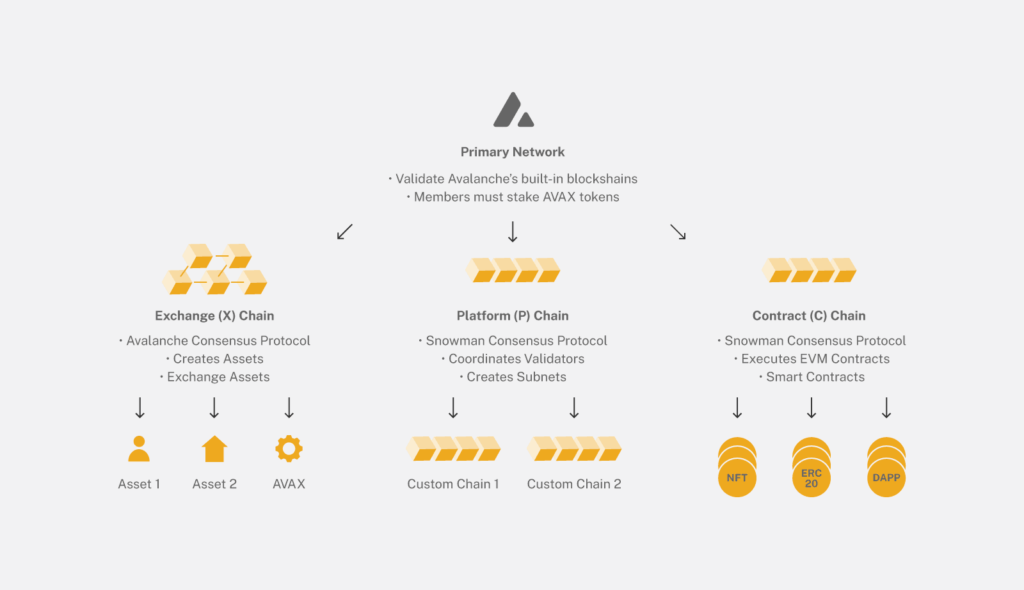
All validators are members of the Primary Network consisting of three blockchains: the Exchange Chain (X-Chain), Contract Chain (C-Chain), and Platform Chain (P-Chain).
In a given round, each validator randomly selects K nodes from the entire validator list (probability of selection is weighted by stake amount) to query for their preferred decision. Each queried validator responds with their preferred decisions, and if the majority of responses returned in a round differ to the node performing the query then it will update its own preferred decision to reflect that and respond to other nodes with that answer.
By having every validator randomly select other validators in order to ask them what their preferences are, participants in Avalanche build confidence in the correct decision shared by all nodes in the network. While one node does not query every other node like in classical consensus, each node performs their own sample of randomly selected nodes, thus is able to scale to hundreds of thousands or millions of nodes without adding lots of additional overhead on each node, as they are querying the same number of nodes. With enough confidence, a decision is finalized immediately. This process happens so quickly that Avalanche rivals major payment systems in its ability to process and clear transactions in the network.
Avalanche supports an arbitrarily large and parameterizable set of adversaries. If the network is parameterized for a 33% attacker, and an attacker has 34% stake, unlike with classical consensus protocols, the attacker can launch a double spend attack which is guaranteed to succeed. However, with Avalanche, this only results just in a slightly higher chance to succeed rather than becoming a guarantee. Because there is no leader, the network is immune to a large class of attacks that other consensus protocol families face. The large number of validators ensures immutability and censorship resistance that proof-of-work protocols, backed by small numbers of mining pools, cannot achieve.
• Peer-to-peer transmission: Any participant can transmit AVAX to another participant with a digital wallet without bureaucracy, banks, excessive fees or delays. AVAX can be transferred among an unlimited number of people, instantly and simultaneously.
• Distributed database: Avalanche is designed to provide unprecedented decentralization with a commitment to multiple client implementations without centralized control of any kind. The ecosystem is designed to avoid divisions between classes of users with different interests. Crucially, there is no distinction and preferences between miners, developers and users.
• Transparency: Avalanche is open-source and the code can be seen and edited by anyone. The network is interoperable, which allows developers to build new permissionless or permissioned interoperable blockchains seamlessly. Network participants can easily create and trade digital smart assets.
• Record keeping: The Avalanche network technically consists of three blockchains that record different types of transactions. Firstly, the exchange chain or X-chain which hosts the native token of Avalanche, AVAX as well as other digital assets. The second is called the Platform Chain or P-chain, which is the metadata blockchain on Avalanche and coordinates validators, keeps track of active subnets, and enables the creation of new subnets. The P-Chain implements the Snowman consensus protocol. The third and final blockchain is the Contract Chain or C-Chain, which allows for the creation of smart contracts using the C-Chain’s API.
• Computational Logic: The Avalanche network relies on computational logic by way of a family of consensus protocols called Snow. The system operates by repeatedly sampling the network at random, and steering correct nodes towards a common outcome. Each node polls a small, constant-sized, randomly chosen set of neighbors, and switches its proposal if a supermajority supports a different value. Samples are repeated until convergence is reached, which happens rapidly in normal operations.
The AVAX Token
AVAX allows stakeholders of the network to:
- Make payments and provide a basic unit of account between the multiple subnetworks created on the Avalanche blockchain.
- Pay network fees.
- Secure the network and validate transactions through the Proof of Stake mechanism also dubbed staking.
AVAX is a capped-supply token.
• Capped at 720 million AVAX tokens, and 50% of those tokens (360 million) will be on the mainnet.
• AVAX serves as the base unit of account in the Avalanche network, provides the base security guarantees, pays for operations, and provides a wide suite of utility services.
• AVAX transaction fees are burned, increasing the scarcity of AVAX.
• About 10% of all tokens are allocated to the founding and non-founding team at AVA Labs.
• All tokens are subject to a vesting schedule.
Token Distribution
Purchaser Distribution
• Seed Sale: This sale was completed in February of 2019, where a total of 18M tokens were sold. Tokens were sold at a price of approximately $0.33 per token. The implied fully-diluted mainnet valuation of this sale was $120M. These tokens were sold to help initiate the development of the Avalanche codebase.
• Private Sale: This sale was completed in May of 2020, where a total of around 24.9M tokens were sold. Tokens were sold at a price of $0.50 per token. The implied fully-diluted mainnet valuation of this sale was $180M. These tokens were sold to distribute AVAX and build staking infrastructure.
• Public Sale: Option A1, Public Sale Option A2, and Public Sale Option B. These tokens are allocated for the current public sale, where at most 17M tokens will be sold. Since Public Sale Option A1 and Public Sale Option B take from the same pool of 12M tokens, public purchasers will decide the final percentages of each allocation. On other hand, in order to allow for a fair and equitable distribution of tokens, Public Sale Option A2 will have its own dedicated pool of 60M tokens. Public Sale Option A1 and Public Sale Option A2 tokens will be sold at a price of $0.50 per token, and Public Sale Option B will be sold at a price of $0.85 per token.
Ecosystem Distribution
• Foundation: These tokens are allocated to an independent, non-profit Singaporean foundation, called the Avalanche Foundation, which manages these tokens for various ecosystem-building initiatives, including marketing, bounties, incentive programs, and more. The current public sale will be conducted by Avalanche Foundation and its affiliates. Any unsold tokens from the sale were returned to the Foundation allocation.
• Strategic Partners: These tokens are allocated with the specific mandate of being distributed to groups, organizations, and enterprises that are building businesses using the Avalanche technology and network. For example, these may include entrepreneurs looking to build a business that does fast international remittance using Avalanche or financial institutions that are looking to tokenize assets on Avalanche through their own subnets.
• Community & Developer Endowment: These tokens are allocated with the specific mandate of being distributed to individuals and groups that are developing core tooling and infrastructure on Avalanche as well as supporting Avalanche through grassroots community building and marketing. For example, these may include Avalanche Hub (previously AVA Hub), Avalanche Ambassadors (previously AVA Ambassadors), Avalanche-X (previously AVA-X) grantees, and more.
• Airdrop: These tokens are allocated with the specific mandate of being distributed to various communities in order to onboard more people to the Avalanche community.
• Testnet Incentive Program: These tokens are allocated for participants that validated in the Avalanche incentivized testnet programs.
Team Distribution
• Team: These tokens are allocated to founding and non-founding members of AVA Labs. Team members, including founders, who have vested tokens prior to launch are voluntarily re-locking all tokens for four years, starting from three months after mainnet launch.
Token Unlocking Schedule
All tokens, except for Public Sale Option B, have some vesting schedule. Seed Sale (1 year vesting), Private Sale (1 year vesting), Public Sale Option A1 (1 year vesting), Public Sale Option A2 (1.5 years vesting), Foundation (10 years vesting), Incentivized Testnet Program (1 year vesting), and Team (4 years vesting) allocations start unlocking from mainnet launch, as outlined in more detail in Section 4.2.1 below. On the other hand, Community & Development Endowment (1 year vesting), Strategic Partners (4 years vesting), and Airdrop (4 years vesting) allocations do not start unlocking from mainnet launch, but instead start unlocking from grant date, as outlined in more detail in Section 4.2.2 below. The percentages in the following sections are shown as a function of the mainnet supply of tokens, namely 360M tokens.
The State of Avalanche
Q1 of 2021 saw several major improvements to the Avalanche platform including the Apricot upgrade that enabled a 50% reduction in transaction fees, improvement in C-Chain block indexing and API upgrades, strengthened default security options and various optimizations in the P-chain, C-chain and networking library. These upgrades greatly reduced the load on each validator and assisted in optimizing the network for scaling to meet future network growth and user demand.
The Avalanche ecosystem experienced exponential growth in Q2 of 2021 with assets under management in DeFi or total value locked (TVL) peaking at $10.55 billion at the end of October. Avalanche’s TVL growth trajectory was accelerated by the Avalanche Foundation’s announcement of Avalanche Rush, a $180 million liquidity-mining incentive program to attract applications and assets to the DeFi ecosystem. Phase 1 of this program was spearheaded by Aave and Curve over a 3-month period, with $20 million AVAX tokens for Aave users and $7M AVAX for Curve users. Other protocols contributing to Avalanche’s significant growth include BENQI, a lending and borrowing protocol native to Avalanche and StakeDAO, a yield optimizer leveraging Aave and Curve. Q2 also saw additional upgrades to the Avalanche platform to support several Ethereum-compatible software improvements.
The Avalanche Bridge (AB) is the key infrastructure piece used to transfer ERC20 tokens from Ethereum to Avalanche’s C-Chain and vice versa. The Avalanche bridge received several upgrades in Q3 for additional chain support and optimization for faster clearing and settlements.
Relatively user friendly, Ethereum transactions take 10 to 15 minutes and Avalanche transactions take only a few seconds, so far $5.62 billion has been transferred from Ethereum on the official AB. The speed of Avalanche’s bridge puts the network in a competitive advantage over networks like Polygon PoS which takes up to one hour and Optimism and Aributrum which take seven days for asset withdrawals. One caveat to AB is that, at the time of writing, it is unable to support transfer of native tokens created on Avalanche, Avalanche have announced however this functionality is on the long-term roadmap. To further incentivize the initial adoption of Avalanche, early users of the bridge were airdropped with a small amount of AVAX tokens. Aside from the official bridge, protocols such as Anyswap and Synapse currently provide bridging of assets for non-Ethereum networks such as Polygon, Arbitrum, Fantom and more. The continuous development of the cross-chain DeFi infrastructure on Avalanche in Q3 2021 was undoubtedly one of the key facilitators of the network usage and growth.
The Avalanche ecosystem currently has +100 dapps spanning DeFi, gaming, NFTs, exchanges and cross-chain solutions. The rise of Avalanche dapps is widely attributed to the EVM compatibility of the native programming language, reducing the barriers of existing Ethereum developers. As of November 2021, Trader Joe is the second leading exchange protocol on Avalanche, after Aave, with $2.04 billion in TVL and 32.85K daily users. The DEX boasts $347 million in daily trading volume and made a record of $1.9 million in single-day trading revenue on November 8th. In comparison, Ethereum’s Uniswap has 35.05k daily users and $10.3 billion in TVL.
This clearly demonstrates how Avalanche’s affordable transaction fees allows less friction and reduces the barriers to entry for DeFi and the long tail of Web 3 users. This chart presents a comparison of daily trading revenue between Pangolin, the second largest DEX on Avalanche and SpookySwap the leading DEX on Fantom.
Reviewing the performance of AVAX in the last year, the YTD growth recorded 2,695%. Validator staking APR is at ~10% with 61.96% of AVAX staked and the network is currently supported by 1,158 distributed validators. A minimum of 2,000 AVAX is required to run a validator node and 25 AVAX to delegate. Assessing network performance, a reported average time to finality was 0.7299 seconds, well within the advertised sub 1 second in Avalanche’s documentation.
Outside of DeFi, Q3 of 2021 also saw Avalanche’s first Initial Litigation Offering (ILO) go live on Republic after its introduction in December 2020. The first of its kind token is a blockchain-enabled litigation financing product open to anyone. Legal financing or third-party litigation funding provides individuals who might otherwise lack the necessary funds to litigate or arbitrate a civil claim with the resources they require. An ILO not only raises the funding to pursue litigation, it tokenizes an economic right in such claims and can represent a legal claim to a portion of the financial recovery as a digital asset. The use of Avalanche’s blockchain technology to democratize financial products in the $10B asset class of litigation financing will allow individuals and small organizations to assert their legal rights against well-funded corporations.
The Future of Avalanche
Looking forward, we expect to see four key areas of growth across the ecosystem, DeFi, enterprise applications, NFTs and culture applications. This will be primarily driven by the Avalanche Foundation’s fund, Blizzard, consisting of $200M worth of contributions dedicated to development, growth and innovation on the network. The fund was announced in early November 2021 and was raised from Ava Labs, Polychain Capital, Three Arrows Capital and Dragonfly Capital to name a few.
Perhaps the most bullish case for any Layer 1 is its ability to integrate real-world use cases for social-economic benefit. Deloitte announced in November 2021 their strategic partnership with Ava Labs to leverage Avalanche’s blockchain technology in the Federal Emergency Management Agency’s new disaster recovery platform. The Close As You Go (CAYG) platform will help state and local governments to demonstrate their eligibility for federal funding and was designed by first responders, public works departments and grant-making agencies. Blockchain technology allows the platform to operate in a decentralized, transparent and cost-efficient manner for authorizing funds to recipients. In addition, it utilizes Avalanche’s security features to gather, process and authenticate documentation accurately to prevent fraud, waste and potential systemic abuse. The ability for Avalanche to streamline recovery efforts, simplify documentation and minimize administrative costs is a clear demonstration of how the integration of blockchain technology will fundamentally change and help build resilient modern financial systems.
The future of Avalanche will likely see a greater number of dapps verticals taking advantage of the network’s fast speed and low transaction fees. In Q4, 2021, we can expect Avalanche bridge upgrades as well as implementation of Apricot Phase 5 with X-Chain Dynamic Fees, X-Chain State Pruning and X-Chain Sync. It will also hail the start of the Blueberry upgrade which will enable the creation of independent blockchains with custom virtual machines and rulesets. These features will provide the essential infrastructure for enterprises and institutions who require greater control over their development and data. Retok is one such service utilizing Avalanche, they aim to enable fractional property ownership and increased liquidity in the real estate market through tokenization.
Focusing on the DeFi user experience, multi-chain wallet integration and the Avalanche wallet will undergo its V6 facelift and expand functionality to mobile devices. Similar to Ethereum Name Service for .eth names, Avvy Domains recently partnered with Avalanche so users will soon be able to register .avax names to their Avalanche wallet addresses. Plans are also in place for greater trading venues and exchange integration for AVAX, removing the need for cross-chain transfers ultimately leading to a more seamless on-ramp experience. These upcoming developments on the Avalanche network are likely to drive greater value creation across the entire ecosystem.
Valuing Avalanche
There are two ways we can think of the potential value of Avalanche’s native asset, AVAX. The first is carrying out a market sizing exercise to compare its value to that of its main competitors as its target market. Secondly, we can compare Avalanche’s current adoption — through the proxy of fees paid on the network — to that of Ethereum in order to understand if the current value of Avalanche can be justified whether there’s product-market fit.
Market Sizing:
The chart below shows the current market capitalization of Solana, Avalanche, Ethereum, and Fantom. Ethereum represents what the market has judged as the current best use-case of blockchain technology while the smart contracts use case can be argued to be just as valuable in the long term. Fantom and Solana are networks that similarly experienced substantial growth in Q3 of 2021 and serve as comparison for ecosystem development.
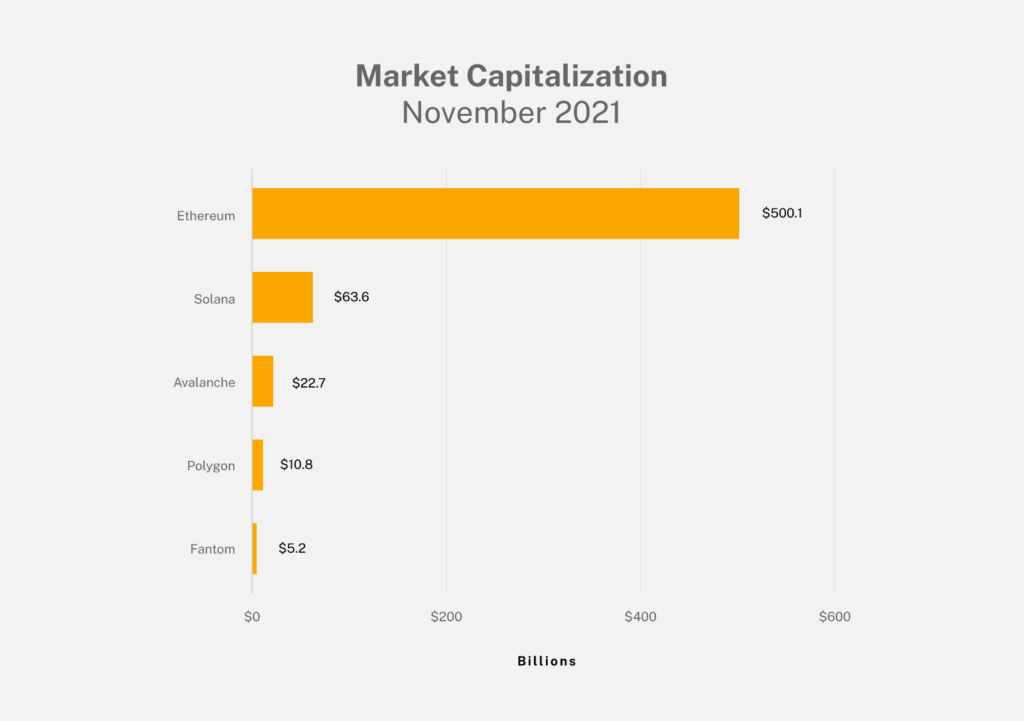
Total Value Locked
This section compares the current TVL of Avalanche relative to other major networks such as Ethereum, Fantom, Polygon, Solana and Bitcoin. TVL can be a useful tool to compare network utilization and a method to measure the flow of capital within DeFi. As the number of DeFi apps grow and the use cases like ILO and CAYG evolve on the Avalanche network, we can expect TVL to grow. The scalability of the network and relatively low transaction costs will likely capture more of Ethereum’s market share.
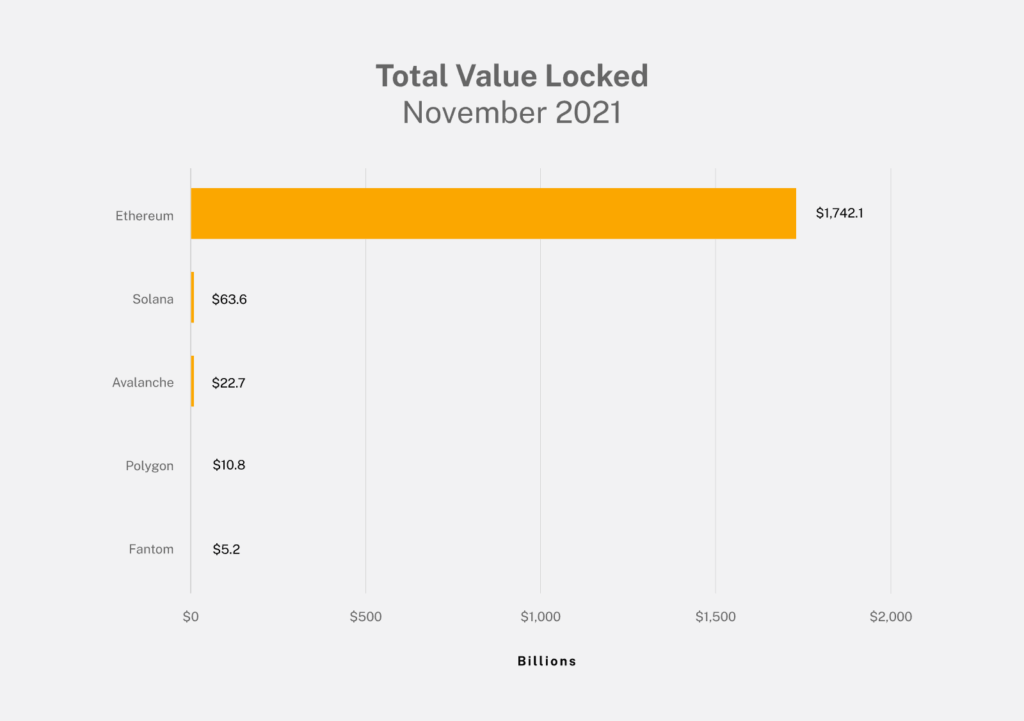
Fees
Revenue generation is often a key metric when assessing network value. By assessing the total number of transactions and the average cost per transaction we are able to estimate the total revenue generated. Fees are a good signal for the overall demand for a given smart contract platform and arguably the strongest barometer of fundamental growth. Avalanche’s estimated annualized revenue is $54.66 million compared to Ethereum’s annualized revenue of $21.28 billion. Along with greater network usage by DeFi applications, gaming, greater institutional adoption, and real world use cases mature, we can expect the number of transactions to exponentially increase, and with it, revenue derived from fees.
Price-to Sales (P/S) Ratio compares a protocol’s market cap to its revenues. Unlike the Price to Earnings ratio, where inflated token prices can be inaccurately depicted, P/S ratio derives the network’s value from tangible revenues. This metric is particularly useful for early-stage protocols where income is often reinvested into growth. A low ratio could imply that the protocol is undervalued and vice versa. An evaluation of historic P/S ratio against its market cap can also demonstrate the consistency of fees and revenue. This chart indicates the P/S ratio for other Layer 1s in comparison to Avalanche. AVAX is yet to launch on several major centralized exchanges, with retail and institutional investors on the precipitous end of recognizing its value, we can expect the P/S ratio to increase dramatically in the short term before stabilizing.
Risks
Technological risks
Avalanche has a limited operating history and has not been validated over a long run. The network launched the genesis block in late September 2020. Despite rigorous audits, the crypto network is still developing and making significant decisions that will affect the design, functionality, and governance. These factors may adversely affect public perception alongside AVAX’s price action.
For example, in February of 2021, the Avalanche network, under heavy load, experienced a trigger of a non-deterministic bug related to state verification. An increase of network traffic due to the launch of Pangolin (DEX) caused the number of processing blocks to increase concurrently. The event caused validators to accept invalid mint transactions, as the rest of the network refused to honor these transactions, it stalled the C-chain. Fortunately the other two Avalanche blockchains, X- and P-chains did not contain the minting bug and the network continued to process transactions.
The problem was quickly identified and although the easiest method to fixing the problem was to rewrite the blockchain and undo accepted transactions, the decentralized nature of the network meant that this was not feasible. Instead, an incrementally deployable patch disabled the cache and introduced the notion of special blocks which respected the invalid mints.
One major downfall of the patch was that it permitted the generation of 790.2 additional AVAX. In order to prevent the number of total AVAX not exceeding the hard cap of 720 mm AVAX, the Avalanche foundation decided to burn the additional AVAX created. Although the code was patched, and the technical bug never had the possibility of losing funds, it was a blatant reminder that blockchain technology is still in its infancy. The rapid rate of development and the relative experience of developers in the space means that no smart contract is immune to flaws despite extensive auditing by third-party firms. The health and integrity of the network will therefore continue to depend on a strong and supportive community.
Adoption risks
Adopting Avalanche is predicated on developers bidding and attempting to launch their applications and users (and developers) then choosing to build and use Avalanche-native applications. To date, there has been sizable investment and funding put towards projects that are building Avalanche applications amounting to $11 billion USD with Aave representing 29% of Avalanche’s assets under management or TVL. Still, actual adoption is limited and relatively small at the moment compared to Ethereum with +$170B in TVL. However, it’s important to note that Avalanche’s total AUM in DeFi grew by 3,164% since mid August while Ethereum’s assets grew by 46% in the same time frame. Part of this outsized growth rate is attributed to liquidity mining incentives and speculation, which at 21Shares, we believe is not a sustainable strategy to build a long term user base. On the other hand, these incentives foster greater innovation and adoption. The open question is to what extent applications on Avalanche will become constructive and meaningful for DeFi and Web 3 in the long run, especially when compared to applications currently existing on Ethereum.
Regulatory risks
Avalanche was funded initially by a token sale and, as such, is vulnerable to some level of potential regulatory scrutiny due to the suspicion of some jurisdictions, namely the United States. As Avalanche continues to further decentralise and build working applications, in a similar vein to what Ethereum has done, the likelihood of serious regulatory scrutiny from any governmental body would likely decrease. It can be argued that Ethereum’s “safety” in the eyes of US-based regulators, who stated that Ether is not a security, is one key moat that it has over the other smart contract networks such as Avalanche.
Disclaimer
This report has been prepared and issued by 21Shares AG for publication globally. All information used in the publication of this report has been compiled from publicly available sources that are believed to be reliable. However, we do not guarantee the accuracy or completeness of this report. Crypto asset trading involves a high degree of risk. The crypto asset market is new to many and unproven and may have the potential to not grow as expected.
There is currently relatively little use of crypto assets in the retail and commercial marketplace compared to relatively large use by speculators, thus contributing to price volatility that could adversely affect an investment in crypto assets. In order to participate in the trading of crypto assets, you should be capable of evaluating the merits and risks of the investment and be able to bear the economic risk of losing your entire investment. Nothing in this report does or should be considered as an offer by 21Shares AG and/or its affiliates to sell or solicitation by 21Shares AG or its parent of any offer to buy bitcoin or other crypto assets or derivatives. This report is provided for information and research purposes only and should not be construed or presented as an offer or solicitation for any investment. The information provided does not constitute a prospectus or any offering and does not contain or constitute an offer to sell or solicit an offer to invest in any jurisdiction.
Readers are cautioned that any such forward-looking statements are not guarantees of future performance and involve risks and uncertainties. Actual results may differ materially from those in the forward-looking statements as a result of various factors. The information contained herein may not be considered as economic, legal, tax, or other advice and users are cautioned against basing investment decisions or other decisions solely on the content hereof.
Du kanske gillar
-
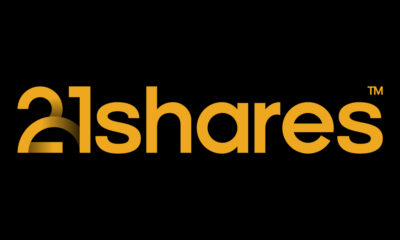

Have We Reached This Cycle’s Peak Yet?
-
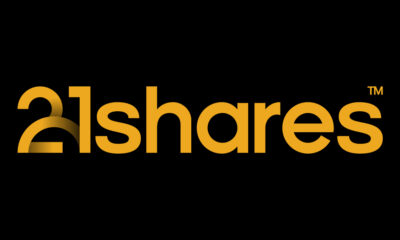

New Year, Same Old Risks?
-
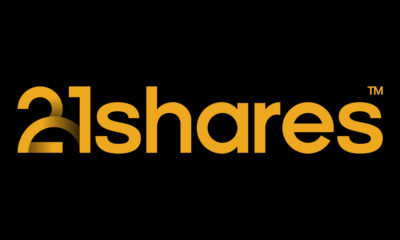

Avalanche9000 Explained: Scaling, Speed, and What’s Next
-
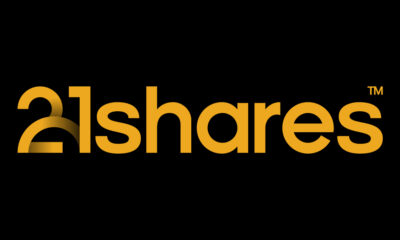

Where Is Crypto Headed in 2025?
-


21Shares släpper sin Market Outlook och förutspår ett starkt år framåt för digitala tillgångar
-


The Layer 2 Boom: Ethereum’s Secret Weapon for Scalability

2024 was a landmark year for bitcoin, solidifying its role as a fully institutionalised asset class.
Institutional inflows into physical bitcoin exchange-traded products (ETPs) reached nearly $35 billion globally, signalling a major shift in how traditional investors view crypto. As bitcoin continued to enhance portfolios’ risk-return profiles, more institutional investors followed suit, reshaping the financial landscape.
Looking ahead, 2025 promises to bring exciting developments across the crypto ecosystem. Here are the top five crypto trends to watch.
Fear of being left behind
The era of bitcoin as a niche investment is over. Institutional adoption is creating a ripple effect, forcing hesitant players to reconsider. Portfolios with bitcoin allocations are consistently outperforming those without, highlighting its growing importance.
Figure 1: Bitcoin in a multi-asset portfolio
| 60/40 Global Portfolio | 1% Bitcoin Portfolio | 3% Bitcoin Portfolio | 5% Bitcoin Portfolio | 10% Bitcoin Portfolio | MSCI AC World | Bloomberg Multiverse | Bitcoin | |
| Annualised Return | 5.77% | 6.46% | 7.83% | 9.20% | 12.57% | 9.07% | 0.56% | 56.24% |
| Volatility | 8.79% | 8.86% | 9.14% | 9.62% | 11.42% | 13.94% | 5.05% | 67.28% |
| Sharpe Ratio | 0.48 | 0.55 | 0.68 | 0.79 | 0.96 | 0.54 | -0.20 | 0.81 |
| Information Ratio | 1.01 | 1.01 | 1.01 | 1.00 | ||||
| Beta | 70% | 71% | 73% | 75% | 81% | 100% | 24% | 181% |
Source: Bloomberg, WisdomTree. From 31 December 2013 to 30 November 2024. In USD. Based on daily returns. The 60/40 Global Portfolio is composed of 60% MSCI All Country World and 40% Bloomberg Multiverse. You cannot invest directly in an index. Historical performance is not an indication of future performance and any investment may go down in value.
With bitcoin’s ability to noticeably improve portfolios’ risk-return profiles, asset managers face a clear choice: integrate bitcoin into multi-asset portfolios or risk falling behind in a rapidly evolving financial landscape. In 2025, expect the competition to heat up as clients demand exposure to this powerhouse cryptocurrency.
Expanding crypto investment options
In 2024, regulatory breakthroughs opened the doors for physical bitcoin and ether ETPs in key developed markets. This marked a critical step towards making cryptocurrencies mainstream, providing seamless access to institutional and retail investors alike.
Figure 2: Global physical crypto ETP assets under management (AUM) and 2024 net flows
Source: Bloomberg, WisdomTree. 02 January 2025. Historical performance is not an indication of future performance and any investment may go down in value.
In 2025, this momentum is expected to accelerate as the crypto regulatory environment becomes more friendly in the United States and as key developed markets follow Europe’s lead and approve ETPs for altcoins such as Solana and XRP. With their clear utility and growing adoption, these altcoins are strong candidates for institutional investment vehicles.
This next wave of altcoin ETPs will expand the diversity of crypto investment opportunities and further integrate cryptocurrencies into the global financial system.
The maturing of Ethereum’s layer-2 ecosystem
Ethereum’s role as the backbone of decentralised finance (DeFi), non-fungible tokens (NFTs), and Web3 is unmatched, but its scalability challenges remain a hurdle. Layer-2 solutions—technologies such as Arbitrum and Optimism—are transforming Ethereum’s scalability and usability by enabling faster, cheaper transactions.
In 2025, Ethereum’s recent upgrades, such as Proto-Danksharding (introduced in the ‘Dencun’ upgrade), will drive layer-2 adoption even further. Innovations like Visa’s layer-2 payment platform leveraging Ethereum for instant cross-border transactions will underscore the platform’s evolution.
Expect Ethereum’s layer-2 ecosystem to power real-world use cases ranging from tokenized assets to decentralised gaming, positioning it as the infrastructure of a truly scalable digital economy.
Stablecoins: bridging finance and blockchain
Stablecoins are becoming indispensable to the global financial system, offering the stability of traditional assets with the efficiency of blockchain. Platforms such as Ethereum dominate the stablecoin landscape, hosting stablecoin giants Tether (USDT) and USD Coin (USDC), which facilitate billions in daily transactions.
Figure 3: Key stablecoin chains
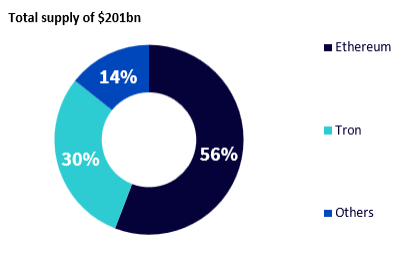
Source: Artemis Terminal, WisdomTree. 05 January 2025. Historical performance is not an indication of future performance and any investment may go down in value.
As we move into 2025, stablecoins will increasingly interact with blockchain ecosystems such as Solana and XRP. Solana’s high-speed, low-cost infrastructure makes it ideal for stablecoin payments and remittances, while XRP Ledger’s focus on cross-border efficiency positions it as a leader in global settlements. With institutional adoption rising and DeFi applications booming, stablecoins will serve as the backbone of a seamless, interconnected financial ecosystem.
Tokenization: redefining ownership and revolutionising finance
Tokenization is set to redefine how we think about ownership and value. By converting tangible assets like real estate, commodities, stocks, and art into digital tokens, tokenization breaks down barriers to entry and creates unprecedented liquidity.
In 2025, tokenization will expand dramatically, empowering investors to own fractions of high-value assets. Platforms such as Paxos Gold and AspenCoin are already showcasing how tokenization can revolutionize markets for gold and luxury real estate. The integration of tokenized assets into DeFi will unlock new financial opportunities, such as using tokenized real estate as collateral for loans. As tokenization matures, it will transform industries ranging from private equity to venture capital, creating a more inclusive and efficient financial system.
For the avoidance of any doubt, tokenization complements crypto by expanding the use cases of blockchain to include real-world applications.
Looking ahead
2025 is set to be a defining year for crypto, as innovation, regulation, and adoption converge. Whether it is bitcoin cementing its position as a portfolio staple, Ethereum scaling for mainstream use, or tokenization unlocking liquidity in untapped markets, the crypto ecosystem is poised for explosive growth. For investors and institutions alike, the opportunities have never been clearer or more compelling.
This material is prepared by WisdomTree and its affiliates and is not intended to be relied upon as a forecast, research or investment advice, and is not a recommendation, offer or solicitation to buy or sell any securities or to adopt any investment strategy. The opinions expressed are as of the date of production and may change as subsequent conditions vary. The information and opinions contained in this material are derived from proprietary and non-proprietary sources. As such, no warranty of accuracy or reliability is given and no responsibility arising in any other way for errors and omissions (including responsibility to any person by reason of negligence) is accepted by WisdomTree, nor any affiliate, nor any of their officers, employees or agents. Reliance upon information in this material is at the sole discretion of the reader. Past performance is not a reliable indicator of future performance.
Nyheter
FGLR ETF gör hållbara investeringar i hela världen
Publicerad
12 timmar sedanden
21 januari, 2025
Fidelity Sustainable Research Enhanced Global Equity UCITS ETF Acc (FGLR ETF) med ISIN IE00BKSBGV72, är en aktivt förvaltad ETF.
Denna ETF investerar i aktier från utvecklade marknader över hela världen. Värdepapper väljs ut enligt hållbarhet och grundläggande kriterier.
Den börshandlade fondens TER (total cost ratio) uppgår till 0,25 % p.a. Fidelity Sustainable Research Enhanced Global Equity UCITS ETF Acc är den enda ETF som följer Fidelity Sustainable Research Enhanced Global Equity-index. ETFen replikerar det underliggande indexets prestanda genom fullständig replikering (köper alla indexbeståndsdelar). Utdelningarna i ETFen ackumuleras och återinvesteras.
Fidelity Sustainable Research Enhanced Global Equity UCITS ETF Acc är en liten ETF med tillgångar på 45 miljoner euro under förvaltning. Denna ETF lanserades den 27 maj 2020 och har sin hemvist i Irland.
Investeringsmål
Fonden strävar efter att uppnå långsiktig kapitaltillväxt från en portfölj som huvudsakligen består av aktier i företag med säte globalt.
Handla FGLR ETF
Fidelity Sustainable Research Enhanced Global Equity UCITS ETF Acc (FGLR ETF) är en europeisk börshandlad fond. Denna fond handlas på flera olika börser, till exempel Deutsche Boerse Xetra och London Stock Exchange.
Det betyder att det går att handla andelar i denna ETF genom de flesta svenska banker och Internetmäklare, till exempel DEGIRO, Nordnet, Aktieinvest och Avanza.
Börsnoteringar
| Börs | Valuta | Kortnamn |
| gettex | EUR | FGLR |
| Borsa Italiana | EUR | FGLR |
| London Stock Exchange | USD | FGLR |
| London Stock Exchange | GBP | FGLS |
| SIX Swiss Exchange | USD | FGLR |
| SIX Swiss Exchange | CHF | FGLR |
| XETRA | EUR | FGLR |
Största innehav
| Värdepapper | Vikt % |
| Microsoft Corp | 5.0% |
| Apple Inc | 4.7% |
| NVIDIA Corp | 4.5% |
| Amazon.com Inc | 2.6% |
| Meta Platforms Inc Class A | 2.4% |
| Alphabet Inc Class A | 2.0% |
| JPMorgan Chase & Co | 1.9% |
| Visa Inc Class A | 1.6% |
| Alphabet Inc Class C | 1.4% |
| Berkshire Hathaway Inc Class B | 1.2% |
Innehav kan komma att förändras
Nyheter
Trump’s inauguration day, BTC all-time high and the US election bullish effect
Publicerad
1 dag sedanden
20 januari, 2025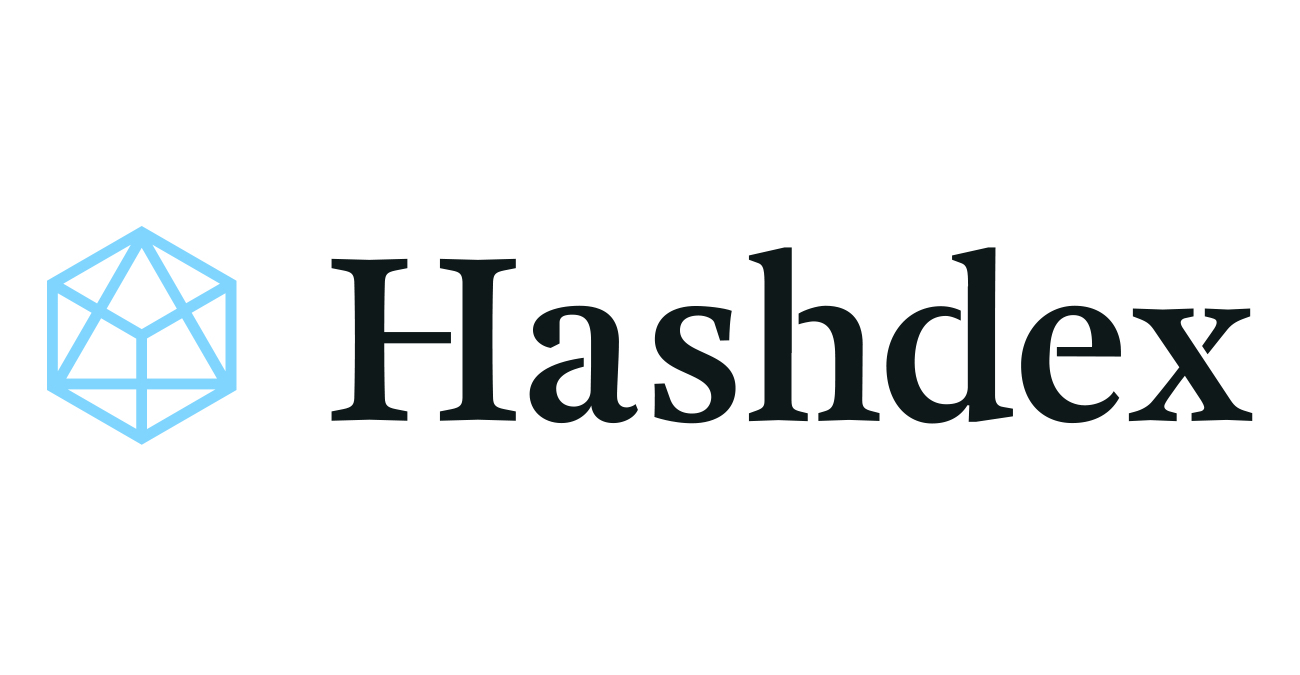
On January 20, 2025, bitcoin (BTC) reached a new all-time high, surpassing $109,000, and this milestone coincided with Donald Trump’s inauguration for his second term as U.S. President.
Historical trends show that BTC has performed exceptionally well in the 12 months following the past three U.S. elections. If history repeats, this could signal another bullish phase. With Trump’s pro-BTC stance and a U.S. Congress aligned on favorable digital regulation, the outlook for the coming months appears highly promising.
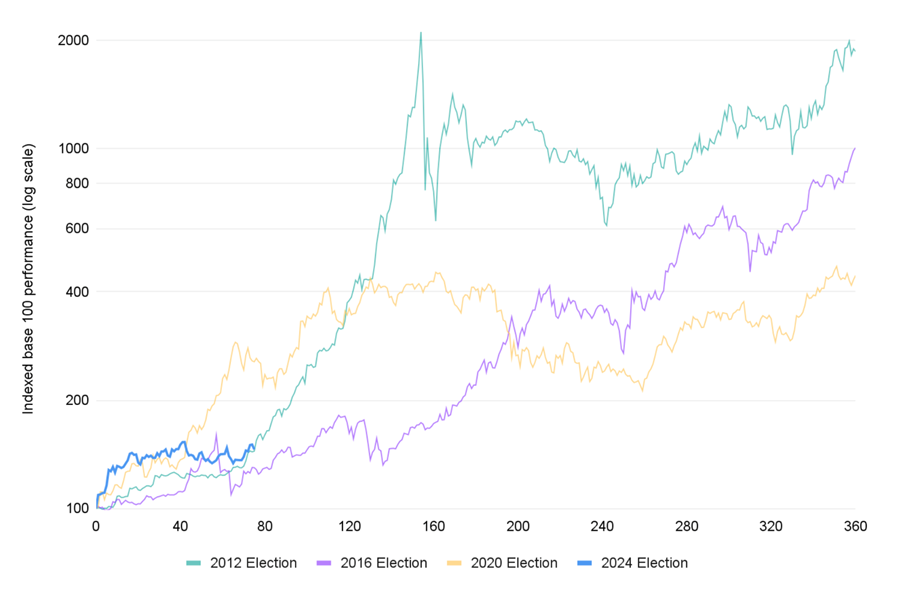
Source: Hashdex Research with data from Messari (from November 6, 2012 to January 19, 2025).
MARKET HIGHLIGHTS | Jan 13 2025 – Jan 19 2025
Bitcoin-backed loans enabled on Coinbase’s L2
• Now customers can borrow USDC in the new base’s lending protocol by using bitcoin as collateral.
• This underscores the importance of onchain innovations as the pillar for future adoption of blockchain technology, in this case enhancing personal finance to be more decentralized and intuitive in a permissionless etho..
ETF filings reiterate bullish regulatory tailwinds
• As Donald Trump’s inauguration approaches, several asset managers have filed applications for new crypto ETF products, including those focused on assets like LTC and XRP.
• This reflects optimism for 2025’s crypto regulations and their potential to transform the regulated products landscape.
Trump to make crypto top priority in US agenda
• U.S. President-elect Donald Trump allegedly plans to issue an executive order making crypto a national policy priority and establishing an advisory council.
• The announcement signals that crypto has gained political importance. Even if not all promises are met, crypto has already crossed the chasm.
MARKET METRICS
The Nasdaq Crypto Index™
This week saw a significant rise in digital assets as the market awaits Trump’s inauguration, with the NCI™ (+15.3%) outperforming all traditional asset classes. The NCI™ (+13.2%) also outperformed BTC (+12.1%), highlighting the value of diversification in a volatile market. The performance was positively impacted by SOL’s strong 46.3% gain, while ETH’s underwhelming 3.0% growth had a dampening effect.
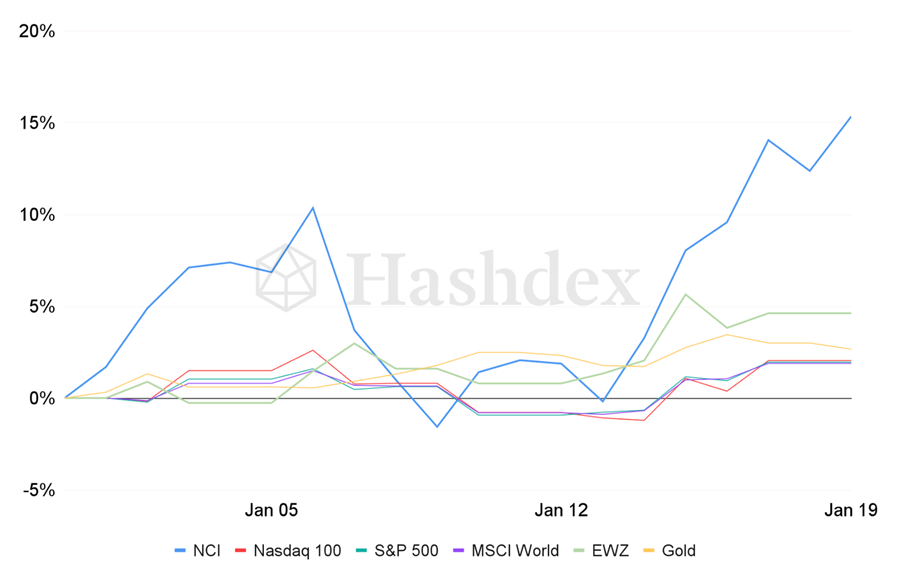
Source: Hashdex Research with data from CF Benchmarks and Bloomberg (from December 31, 2024 to January 19, 2025).
It was a strong week for the NCI™ , with SOL leading the pack (among others, like XRP and LINK), surging 46.3%, while BTC (12.1%) and ETH (3.0%) lagged behind. This price action seems driven by excitement around Trump’s inauguration and the crypto-friendly environment his promises suggest.
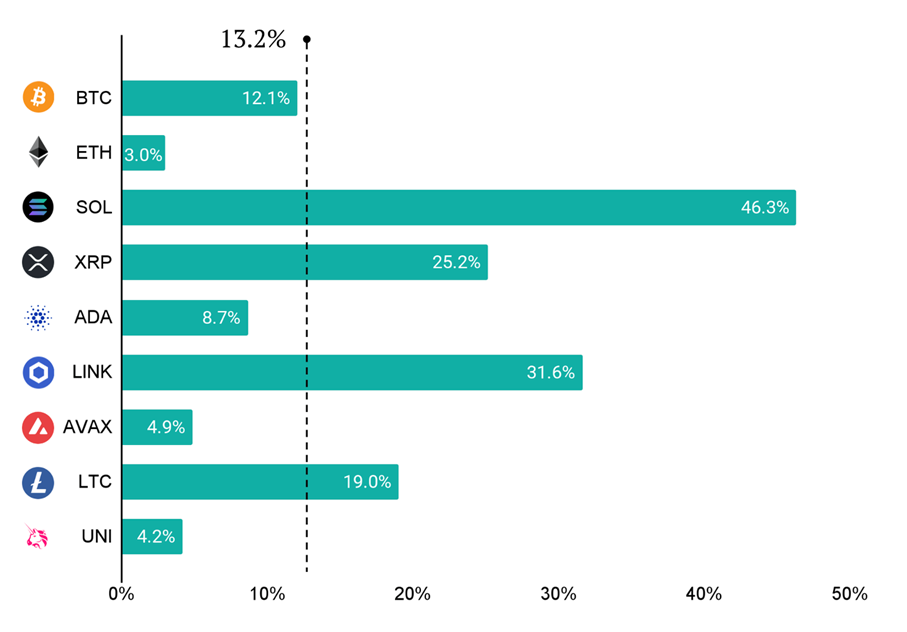
Source: Hashdex Research with data from Messari (from January 12, 2025 to January 19, 2025).
Indices tracked by Hashdex
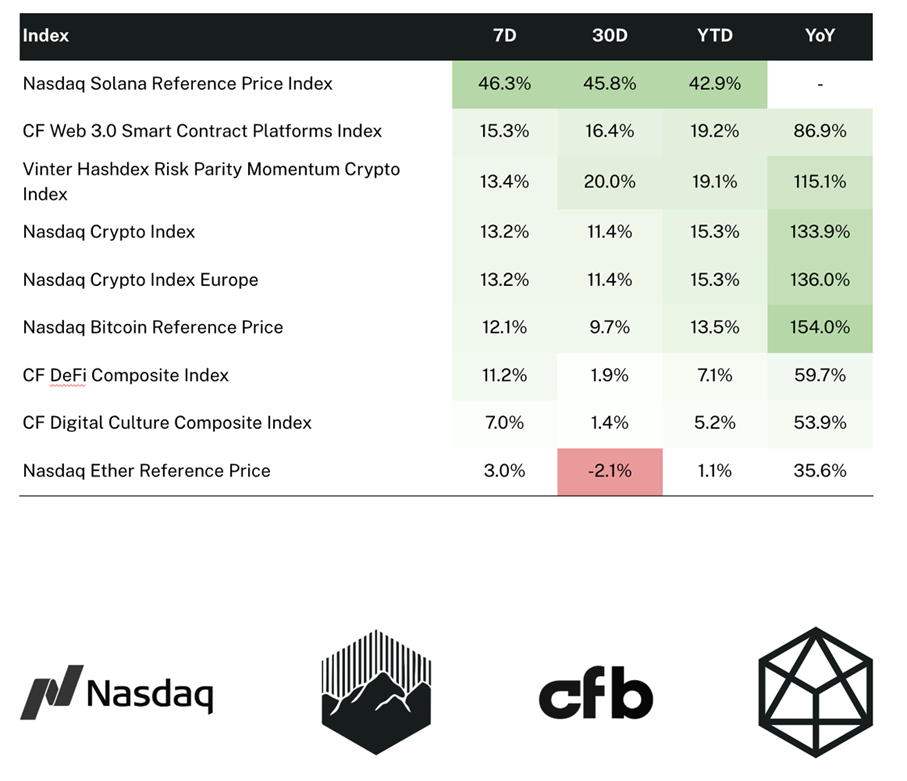
Source: Hashdex Research with data from CF Benchmarks and Vinter (from January 19, 2024 to January 19, 2025).
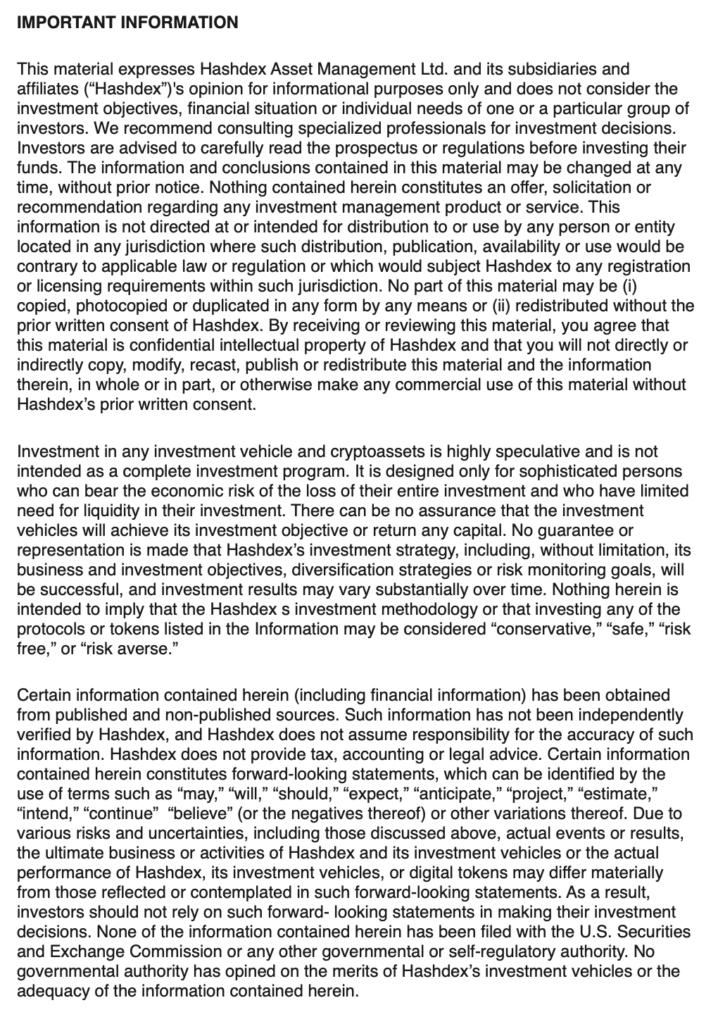

5 crypto trends to watch in 2025

FGLR ETF gör hållbara investeringar i hela världen

Trump’s inauguration day, BTC all-time high and the US election bullish effect

AXA IM antar SDR-märkningar för tre aktiefonder i Storbritannien

HSDD ETF köper aktier i hållbara företag från den utvecklade världen

De mest eftersökta ETFerna i december 2024

Post-election rally cools at year end

De bästa ETFerna för värdeaktier

BlackRock slår rekord med lanseringen av bitcoin ETF

Hector McNeil kommenterar Trumps krav på Natos försvarsutgifter
Populära
-

 Nyheter3 veckor sedan
Nyheter3 veckor sedanDe mest eftersökta ETFerna i december 2024
-
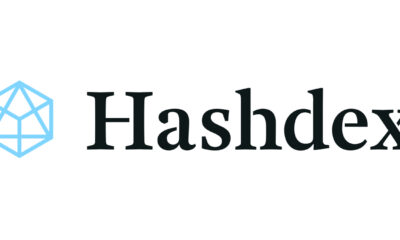
 Nyheter2 veckor sedan
Nyheter2 veckor sedanPost-election rally cools at year end
-

 Nyheter3 veckor sedan
Nyheter3 veckor sedanDe bästa ETFerna för värdeaktier
-

 Nyheter3 veckor sedan
Nyheter3 veckor sedanBlackRock slår rekord med lanseringen av bitcoin ETF
-

 Nyheter3 veckor sedan
Nyheter3 veckor sedanHector McNeil kommenterar Trumps krav på Natos försvarsutgifter
-

 Nyheter3 veckor sedan
Nyheter3 veckor sedanBuffertstrategin på Nasdaq-100 med december 2024/2025 som ny målperiod
-
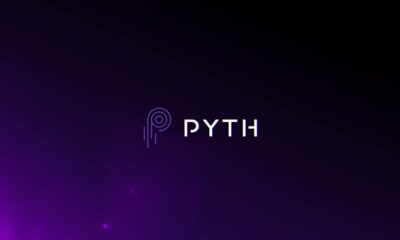
 Nyheter4 veckor sedan
Nyheter4 veckor sedanValour PYTH SEK spårar priset på kryptovalutan PYTH
-

 Nyheter4 veckor sedan
Nyheter4 veckor sedanJREZ ETF investerar i företag från Eurozonen med höga ESG-betyg


